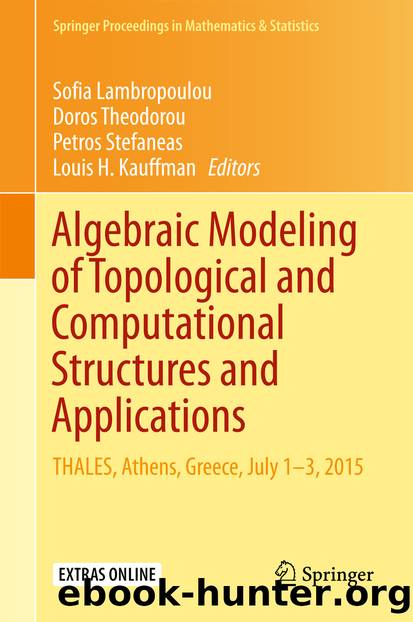Algebraic Modeling of Topological and Computational Structures and Applications by Sofia Lambropoulou Doros Theodorou Petros Stefaneas & Louis H. Kauffman

Author:Sofia Lambropoulou, Doros Theodorou, Petros Stefaneas & Louis H. Kauffman
Language: eng
Format: epub
Publisher: Springer International Publishing, Cham
Fig. 11.10Absolute self-linking of single 25 step chains as a function of alignment constraint and tubular radius
Fig. 11.11Effect of tube radius and alignment constraint on the mean absolute eigenvalues of a PBC system generated by three independent filaments of length 25
In Fig. 11.11 we show the evolution of the absolute values of the three eigenvalues of a PBC system generated by three independent filaments of length 25. Here, one observes a decreasing tendency in the magnitude of the eigenvalues with increasing tube radius and an increasing tendency with increasing alignment constraint. While one may expect a random system to exhibit a stronger degree of entanglement, we have seen that these filaments have smaller diameter (or squared radius of gyration) thereby offering them a significantly smaller opportunity to entangle with nearby filaments whereas filaments subject to an alignment constraint have a significantly larger number of adjacent filaments with which they may entangle. Thus, we see that the magnitude of the eigenvalues increase with increasing alignment. In addition, for a fixed alignment constraint, the magnitude of the eigenvalues decreases with increasing tube radius across the range of radii presented here, i.e. from 0.1 through 5.0 showing that the filamental structure widely explores the cylindrical tube leading to a decreasing density leading to decreasing entanglement.
Consistent with our earlier analysis, we find that a random system displays the smallest entanglement as measured by the magnitude of the eigenvalues, see Fig. 11.12. In Fig. 11.13 we see that the two eigenvalues of larger magnitudes are rather larger than the random system but tend to get smaller with increasing tube radius while the smallest is relatively stable in magnitude. Since the character of this decrease in the magnitude of the eigenvalues holds across the scale of the alignment constraint, we expect that it is an artifact of the decrease in density of the filaments with increasing tube radius. Considering, in Fig. 11.14, the change in magnitude of the eigenvalues for alignment constraint of 0.85, we do not see any meaningful change in magnitude with increasing tube radius as the magnitudes remain roughly constant at the largest eigenvalue measures of entanglement.
Fig. 11.12Effect of random alignment, fixed at 0.00, on length 25 filament; radial scale 0.10–5.00
Download
This site does not store any files on its server. We only index and link to content provided by other sites. Please contact the content providers to delete copyright contents if any and email us, we'll remove relevant links or contents immediately.
| Applied | Geometry & Topology |
| History | Infinity |
| Mathematical Analysis | Matrices |
| Number Systems | Popular & Elementary |
| Pure Mathematics | Reference |
| Research | Study & Teaching |
| Transformations | Trigonometry |
Modelling of Convective Heat and Mass Transfer in Rotating Flows by Igor V. Shevchuk(6391)
Weapons of Math Destruction by Cathy O'Neil(6142)
Factfulness: Ten Reasons We're Wrong About the World – and Why Things Are Better Than You Think by Hans Rosling(4694)
Descartes' Error by Antonio Damasio(3230)
A Mind For Numbers: How to Excel at Math and Science (Even If You Flunked Algebra) by Barbara Oakley(3217)
Factfulness_Ten Reasons We're Wrong About the World_and Why Things Are Better Than You Think by Hans Rosling(3199)
TCP IP by Todd Lammle(3134)
Fooled by Randomness: The Hidden Role of Chance in Life and in the Markets by Nassim Nicholas Taleb(3044)
Applied Predictive Modeling by Max Kuhn & Kjell Johnson(3018)
The Tyranny of Metrics by Jerry Z. Muller(3000)
The Book of Numbers by Peter Bentley(2909)
The Great Unknown by Marcus du Sautoy(2646)
Once Upon an Algorithm by Martin Erwig(2598)
Easy Algebra Step-by-Step by Sandra Luna McCune(2582)
Lady Luck by Kristen Ashley(2532)
Practical Guide To Principal Component Methods in R (Multivariate Analysis Book 2) by Alboukadel Kassambara(2497)
Police Exams Prep 2018-2019 by Kaplan Test Prep(2483)
All Things Reconsidered by Bill Thompson III(2355)
Linear Time-Invariant Systems, Behaviors and Modules by Ulrich Oberst & Martin Scheicher & Ingrid Scheicher(2333)
